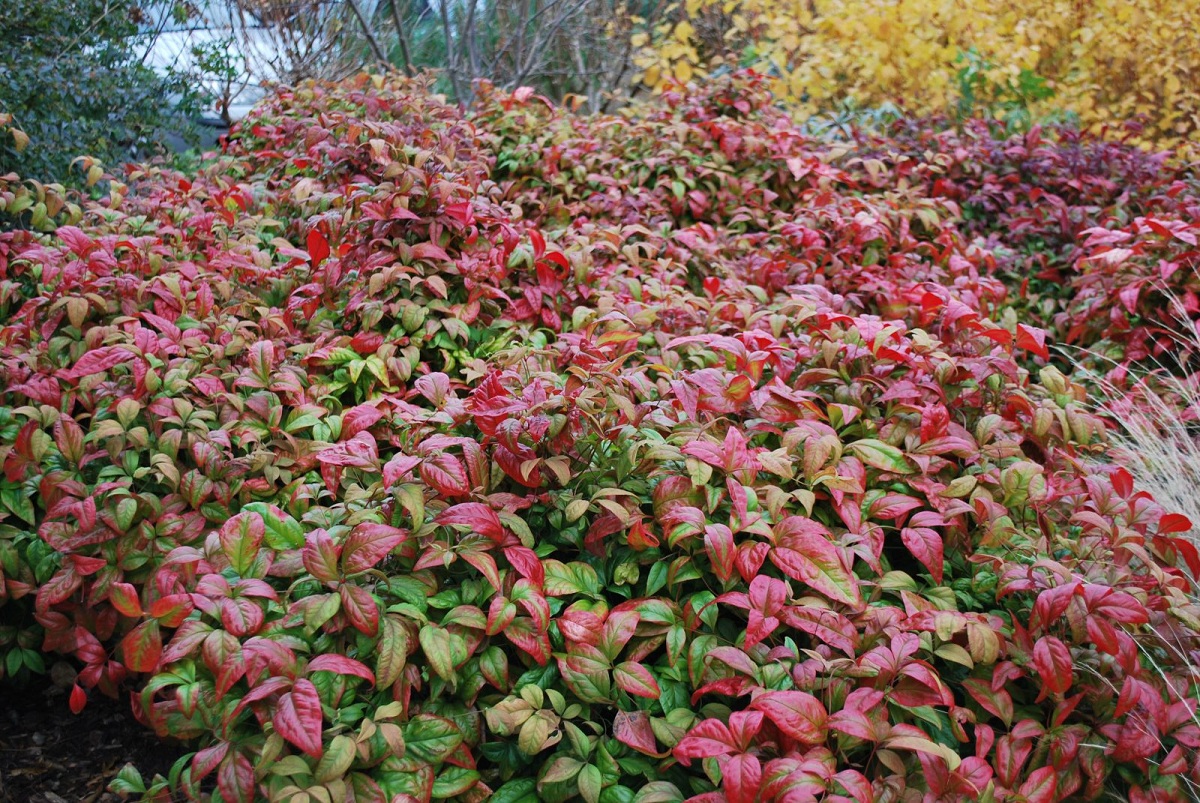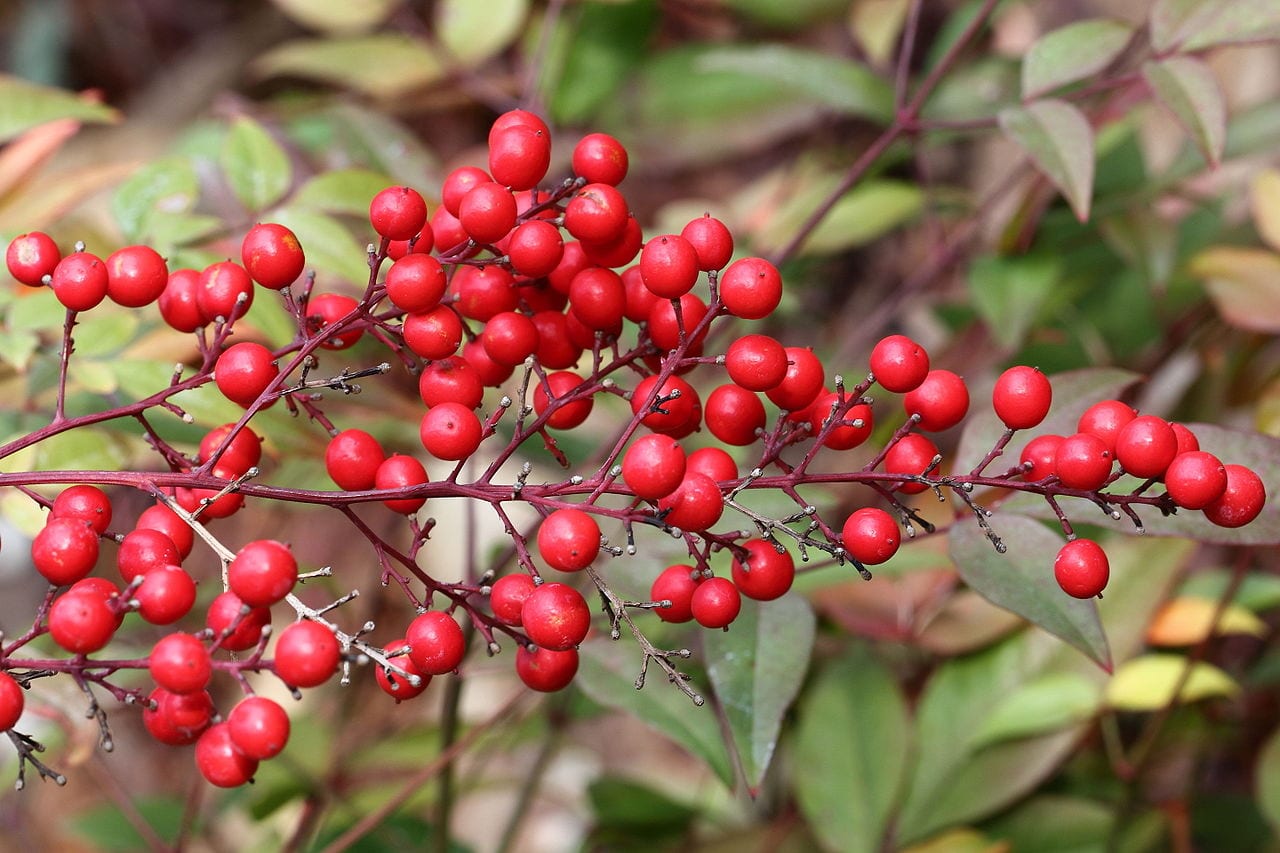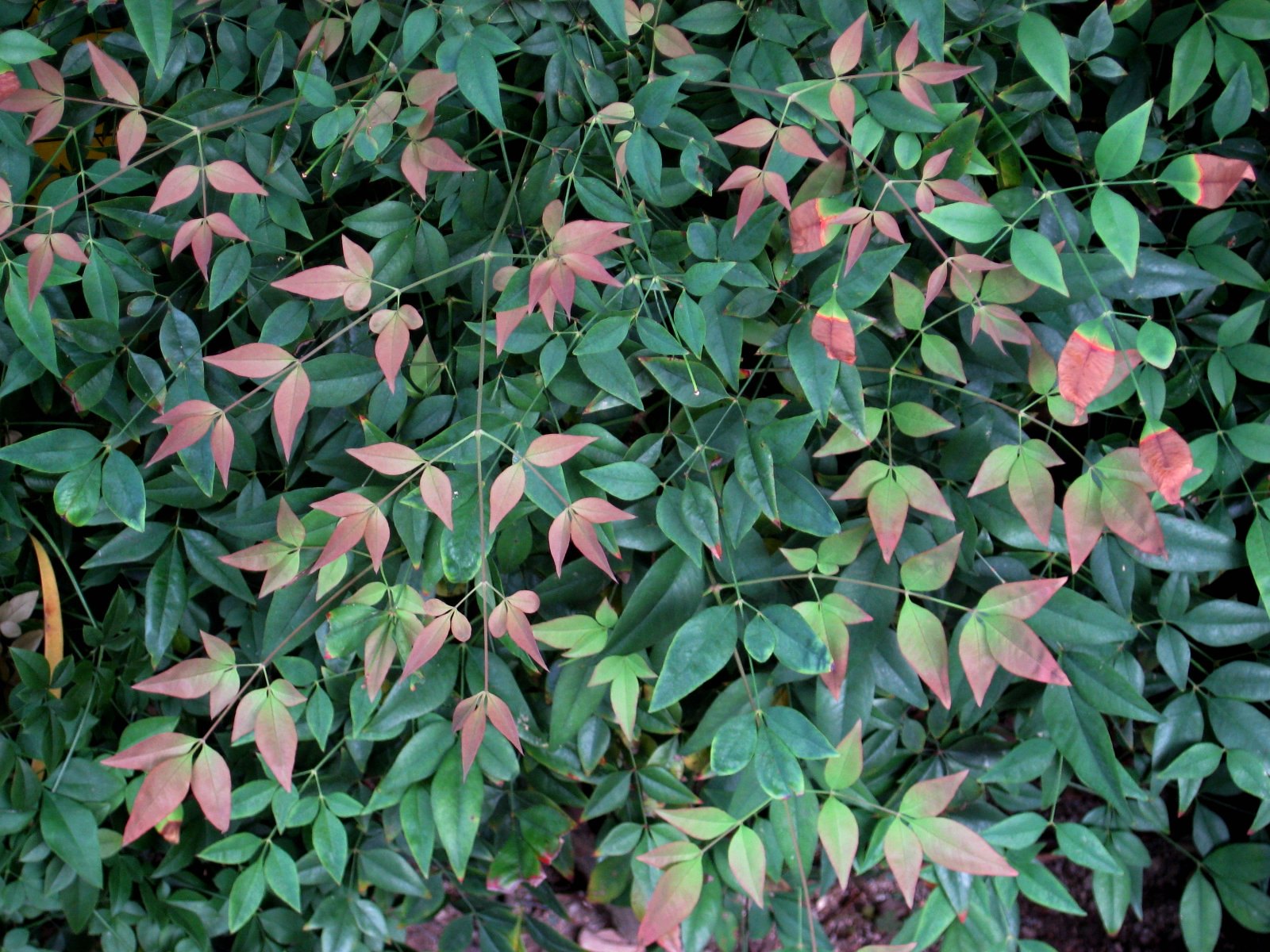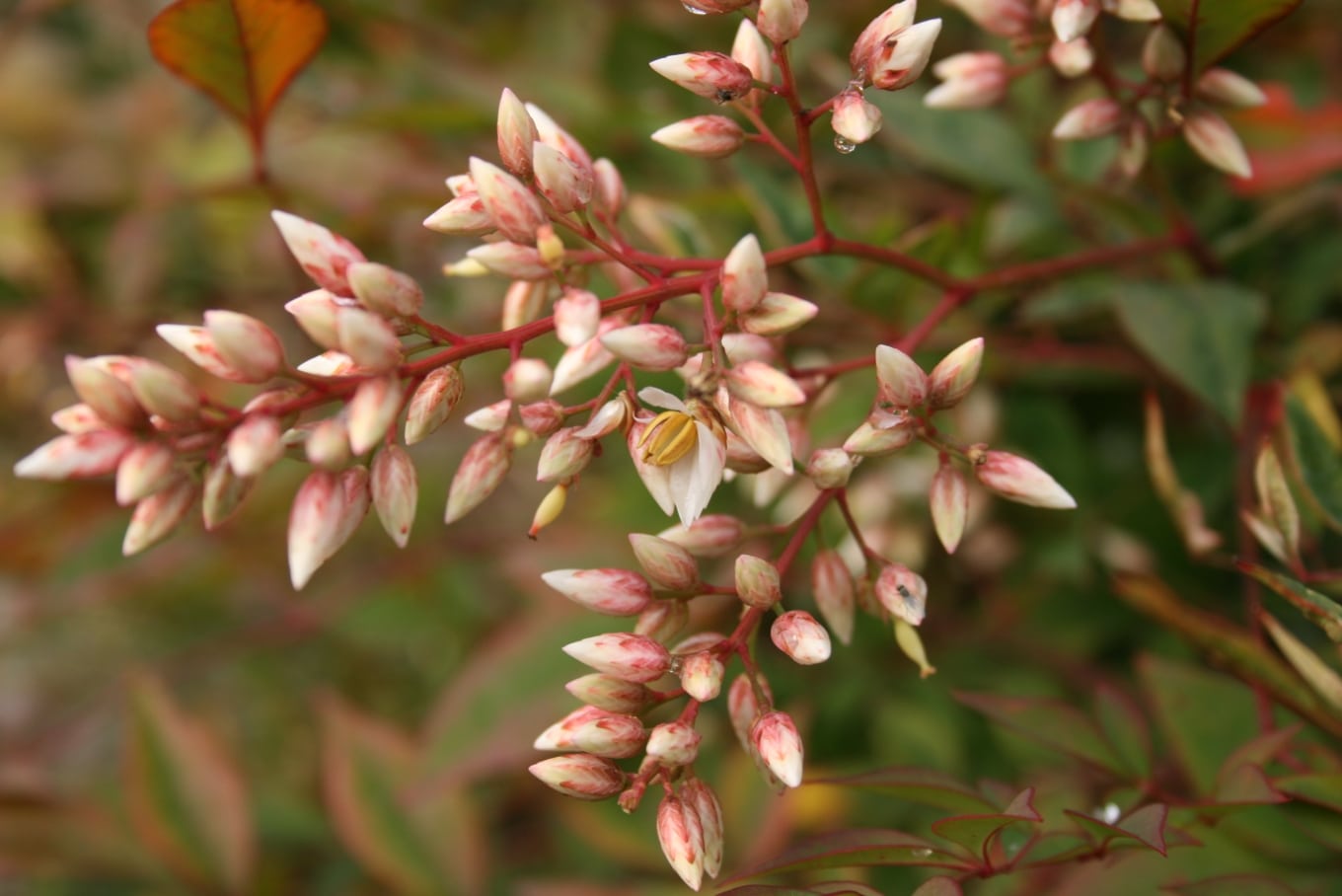
Spectacular plants grow in China and Japan, such as japanese maples or as our protagonist, the domestic nandinaAlthough you may know it better by its other names, such as Sacred Bamboo or simply Nandina. This plant is an evergreen shrub ideal to have in any type of garden, whether large or small, and it also serves to decorate patios and terraces.
But, do you know how to take care of the Nandina plant? Whether you have just entered the world of gardening or if you have been around for a while and want to have a different bush than those that can be found in nurseries in the best conditions, this article is for you.
Main characteristics of the domestic nandina

La domestic nandina It is a plant that is characterized by having green leaves that turn red or orange in autumn. It reaches a height of about 2m, and it resists frosts down to -7ºC without problems. However, it is not capable of withstanding high temperatures. If temperatures are above 35ºC, it must be kept with the substrate / soil moist to prevent its roots from drying out.
Given the chromatic beauty of its leaves, it can be used as an ornamental plant during different times of the year. Although it is commonly called sacred bamboo, it must be said that it is not actually a bamboo. This plant belongs to the Berberidaceae family and has the appearance of a woody shrub growing quite tightly.
The famous leaves of this plant are of the compound and perennial type. They are up to about 50 centimeters long. When the plant is young, its vegetative organs have a special peculiarity. And it is that they turn bright red or pink when spring arrives. This tone is acquired before acquiring the medium green color typical of maturity. Another fundamental aspect of the leaves is that they return to have this intense red or pink color when the leaves are about to fall. This color also serves as an indicator to know the status of the sheets.
how is the flower domestic nandina?
By having these changes in the colors of the leaves, the domestic nandina it becomes a plant capable of aesthetically combining with other blooms that take place in summer. These flowers they are presented in large panicles that are composed of small white flowers that are grouped at the ends of the branches.
As for the fruits of this plant, they are bright red berries. It is quite small in size and has a globular appearance. They tend to persist for a long time, enduring the coldest winters. If you are in an area with excessively hot summers, it is possible that this plant will not produce fruits due to the high temperatures.
Nandina domestica plant requirements
This plant, as we have mentioned before, has greater rusticity in terms of cold rather than heat. Only if the temperature is below -10 degrees and frequently, we can see that they begin to lose the leaves at the bottom. It has to be too extreme a winter for this plant to not be able to survive it.
It is important that the pH of the soil is slightly acidic, between 5 and 6, to prevent its leaves from having chlorosis, and that it has good drainage. In the event that we want to have it in a pot, we will use a substrate for acidophilic plants (you can buy it here) mixed with 20 or 30% perlite.
Necessary care

Image - Flickr / guzhengman
The first thing to consider is the location. The most suitable location will be the one where it can be exposed to direct sun, except if the climate is very warm, like the Mediterranean for example, where it will grow much better in semi-shade. In any case, to help it be even more beautiful, we can fertilize it in spring and summer with specific fertilizers for acid plants following the instructions specified on the packaging.
Irrigation has to be frequent, especially in the hottest months of the year. As a general rule, we have to water every 3 days in summer and every 7-8 days the rest of the year. In case of doubt, you have to check the humidity of the soil / substrate, for example inserting a thin wooden stick to the bottom and, when removing it, see if it comes out more or less clean, which would indicate that the earth is dry, or If, on the contrary, it comes out with a lot of soil attached.
There are no known pests or diseases, and it is not necessary to prune it. Of course, if you see that it is having a disorderly growth and you want to give it shape, you can do it at the end of winter, when the risk of frost has passed.
Propagation of the domestic nandina
Since it can have great ornamental value in our garden, it can be interesting to learn how we should propagate it. As we have mentioned before, it is a plant that prefers acidic to neutral soils. To keep it in good condition at all times, it needs a high level of humidity. In the summer time, when temperatures are much higher, it needs a greater amount of humidity.. This is because it is a plant that does not withstand high temperatures very well.
If we move to the garden and the area where we live tends to have abundant rainfall, it is interesting to prepare the soil well. And it is that the drainage of the soil is a fundamental aspect for the survival of this plant. Both common irrigation and rain can cause waterlogging if the soil does not have good drainage. The domestic nandina not very good at surviving flooding. It must be protected from the wind at all times.
If you want to propagate this plant, the ideal is to do it by seeds. It can also be done by division of clumps or by cuttings. If we do it by seed, we must know that germination occurs very slowly. The most reliable method to be able to reproduce this plant more quickly is the propagation of semi-mature cuttings. These stakes must be taken in the summer time and kept in greenhouses during the coldest season of the year.. Thanks to this maintenance in greenhouses, the plant can be propagated more easily.

Image - Wikimedia / Sten Porse
I hope that with this information you can learn more about the domestic nandina.
Hello Monica
I have planted a nandina in universal substrate and in semi-shade, the truth is that it is stupendous.
I have acquired a larger one, and I want to transplant it with the one I had, both, to a larger planter, and to a slightly sunnier area.
Can I transplant it now?
Can I transplant it with universal substrate?
Can I move them to that sunnier area?
Thanks in advance for your help.
A hug,
Hello Antonio.
It is better than transplants in spring. Now the cold will not be long in coming, and they might suffer.
You can put a universal substrate without problems 🙂, and as long as the sun does not directly shine on them they will grow well.
A greeting.
Monica, I would only give them the sun for a bit in the morning
You can try one or two days to see. Anyway, if it's the early morning sun (until 10-11), I don't think anything will happen to them 🙂.
Hi! I bought a canteen this year in spring and have it in a well-drained medium pot. They told me that in autumn I would have some very nice red berries but none have come out. Is a nandina possible without its characteristic berries? What could I have done wrong? Much sun maybe?
Hello Maui.
It may be that he is still young, or that the pot has been too small for him.
Another possible reason is that it is in an area with a very hot and dry climate, with temperatures of 30ºC or more in summer, and with mild winters. if so, I recommend putting it in semi-shadow.
Regards!
They gave me a small nandina, thank you very much for the information, I will wait in spring to transplant it
Congratulations on the gift 🙂
Hello !
I have a Nandina in full sun and I would like it to be more dense with leaves and leafy. What I can do ? Now winter is ending.
regards
Camilo
Hello camilo.
When the temperature rises above 15ºC you can start to fertilize it with a universal fertilizer. This will bring out many new leaves.
To make it more bushy, cut the stems by giving the plant a more or less rounded shape.
A greeting.
Hellooo…. greetings a month ago we bought a nadina ... in February. Bella but the leaves were almost all red it only has green below. .. and almost all the leaves began to fall and I pruned the dry branches .. but it is still the same, it is in the pot I still do not know if it is normal for the winter or some other cause ... it helps thanks.
Hello Luciana.
How often do you water it? It should not receive a lot of water: only two or three times a week in summer and somewhat less the rest of the year.
If you have put a plate underneath, you have to remember to remove the water that has been left over after each irrigation.
A greeting.
I love Nandinas and the article has been very useful to me. In autumn they are beautiful.
We are glad that it has been useful to you 🙂
I don't think I saw. The fruits are not edible, right? I have many children at home and many fruit trees. They know that at home they can eat fresh fruit almost all year round. Thanks
Hello Maria Elena.
No, the fruits of the nandina are not edible.
regards
thanks for the article, very interesting. I didn't know anything about the bossy, I have one at home and I transplant it because it is drying up, I hope for the result because it is a beautiful plant.
Hi Susan.
We are glad that it has been of interest to you. But if it is drying out, see if the problem may be watering, either by excess or by lack. Here is an article on the subject: click.
A greeting.